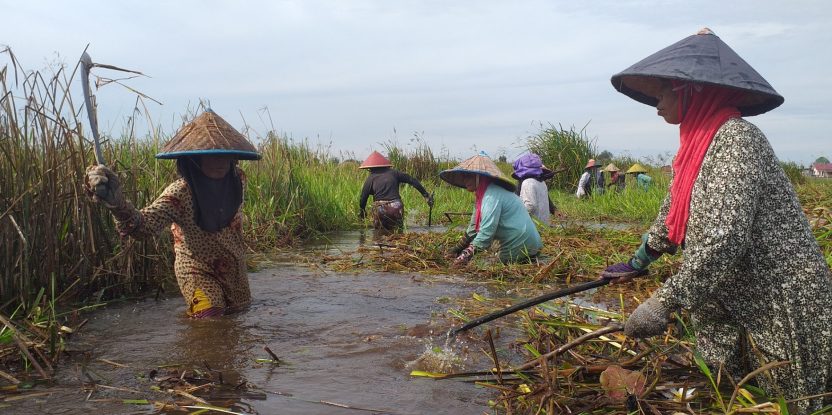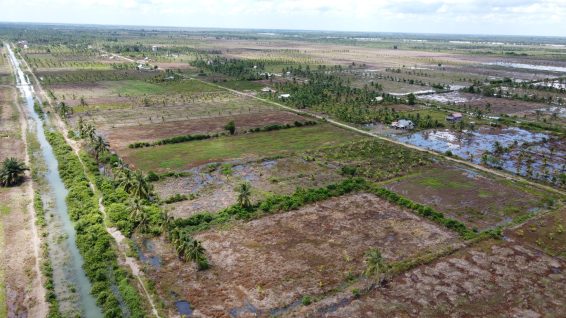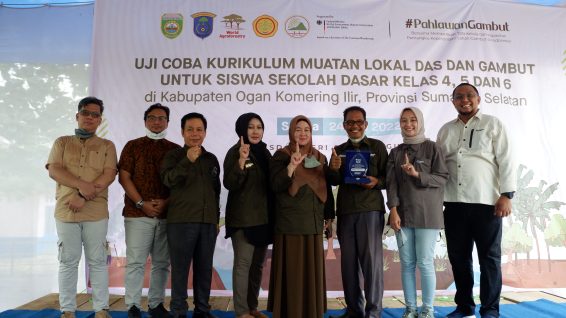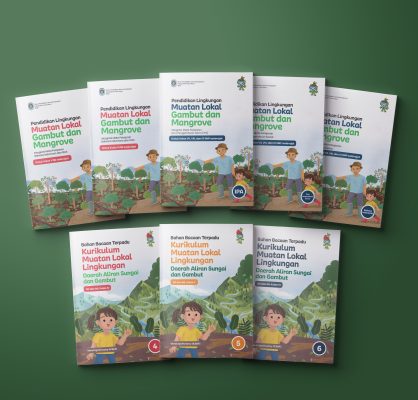
In schoolyards across West Kalimantan and South Sumatra, Indonesia, junior high students are heard discussing the cucumbers they planted, the tomatoes they harvested, and the pineapple jam they just made. All of it is spurred by a newly acquired knowledge of how to sustainably manage one of the planet’s most extraordinary yet unappreciated ecosystems.
Indonesia is home to the Earth’s largest tropical peatlands, a type of wetland that sits on thick layers of semi-decayed vegetation accumulated over millennia. Although peatlands cover only 3% of the global land surface, they stock an estimated 30% of all soil carbon and are important in ensuring a reliable source of freshwater.

An aerial view of peatlands in South Sumatra, highlighting how land use plays a vital role in supporting ecosystems, carbon storage, climate change mitigation, and sustainable agriculture in the region. Photo by Andy Prahmono/CIFOR-ICRAF.
As peatlands are drained and cleared to make way for subsistence farming or industrial plantations, fires can easily spread, unleashing a carbon bomb, releasing a toxic haze, and causing billions in damage, as happened in Indonesia in 2015.
However, students in those two Indonesian provinces are learning that simple practices like harvesting only above-ground biomass, cultivating wetland plants, and preserving the grassland cover can provide revenue while conserving peat ecosystems and their vital services to humanity.
“A lot of the people living in and around peatlands don’t really know how to protect and sustainably manage these ecosystems, meaning it is critical to educate youth on these matters through the school curriculum and informal community learning activities,” says Sonya Dewi, Asia director at the Center for International Forestry Research-World Agroforestry (CIFOR-ICRAF).
In response, the initiative Peat-IMPACTS Indonesia has pioneered the first-ever curriculum on peatlands for primary and junior high students, adapting the materials to the ecological context and culture in each province and sparking a model they now hope expands across peat-rich districts in Indonesia.
Seeds of change
The curriculum was co-created with teachers, school administrators, district education officials, historians, and culture experts and then embedded into existing major subjects. Science and Bahasa Indonesia learning books now showcase examples and stories about peatlands.
The ultimate objective is to improve the students’ understanding of peatlands, why they matter, and the threats they face, equipping them to preserve these unique ecosystems through practical tips and a heightened sense of environmental stewardship.
Crucially, in early 2023, the three district governments involved in the pilot enacted a decree mandating schools to adopt the curriculum. As of today, it has reached 248.000 students in 1,530 primary and junior high schools, sowing the seeds of long-term change the initiative is after.
“Youth will have a profound influence on the future of peatlands as they become leaders in governing institutions, the private sector, and their communities,” says Peat-IMPACTS project coordinator Feri Johana. “In educating the new generations today, we hope they will champion pro-peatland policies, regulations, and activities tomorrow.”
Children are typically enthusiastic about sharing what they learn, like how to identify peatlands, measure moisture content and select suitable plants for cultivation. As such, they spread their knowledge among rural families and communities, creating a rippling effect beyond the classrooms.

Teachers, school administrators and district education officials gathered for peatlands and youth education. Photo by CIFOR/ICRAF
Citizen science and competitions
When Peat-IMPACTS started, there was a wealth of technical and scientific publications on peat ecosystems and tree-based paludiculture and agriculture in wet or rewetted peatlands. What was lacking were the materials and strategies to get the message across to a key audience —the people living in and around peatlands.

Locally developed curriculum on peatlands co-created by teachers, school administrators and historians. Photo by CIFOR-ICRAF
In South Sumatra, for example, the project helped publish a series of children’s storybooks authored by a community leader from the area. Local authorities now host read-aloud competitions among participating schools, further raising awareness in rural settings.
The initiative also created two mascots inspired by local plant species and named after the project in each pilot province: Gale in West Kalimantan and Gaveri in South Sumatra —yet another tool to engage children.
“Conserving peatlands requires an all-of-society, all-of-government approach, and creative ways of reaching diverse audiences, from farmers to policy-makers and the general public,” says Johana, adding that citizen science is part of that effort.
The project recently launched Wikigambut, a collaborative online encyclopedia on peatlands. The portal allows contributors to share information and practical insights on all things related to peatland, making it an open and dynamic source of information that complements ongoing work in schools and villages.
“Our more than 170 contributors summarize scientific papers, write articles, share highlights from seminars, and co-host activities, building an inclusive knowledge base along the way,” says Rabbirl Yarham, the chairman of the WikiGambut Community in West Kalimantan. Inputs come from higher-education institutions, farmers, and community groups alike.
Peatlands for the future
An estimated 50% of Indonesia’s peatland areas have already been destroyed or degraded by fires and land conversion, infusing a sense of urgency to restoration, conservation, and sustainable management efforts.
Since their inception in 2022, the peat curriculum pilots have succeeded in improving the understanding of these ecosystems among students, schoolteachers, and local authorities, and have sparked regulatory changes and a greater social awareness.
“It is absolutely critical to continue educating local communities about the importance of peatlands, starting from an early age,” says Omief Tachliatush Sholihah, a sixth-grade elementary teacher in South Sumatera province.
Researchers now hope the curriculum is gradually adopted across all districts in the three pilot provinces and beyond, transforming perceptions, attitudes, and practices to preserve peatlands —and their vital benefits— for future generations.
We want you to share Forests News content, which is licensed under Creative Commons Attribution-NonCommercial-ShareAlike 4.0 International (CC BY-NC-SA 4.0). This means you are free to redistribute our material for non-commercial purposes. All we ask is that you give Forests News appropriate credit and link to the original Forests News content, indicate if changes were made, and distribute your contributions under the same Creative Commons license. You must notify Forests News if you repost, reprint or reuse our materials by contacting forestsnews@cifor-icraf.org.